In yesterday’s Opinion piece we laid out some of the facts about the grouse shooting industry and why we will never call it ‘glorious’. We explained that the 12th of August (the ‘Inglorious 12th’) marks the start of a key ‘season’ for the shooting industry, and that over the next 121 days that industry will aim to sell hundreds of thousands of Red Grouse to shooters to kill.
We also said that as well as the slaughter of hundreds of thousands of Red Grouse (from 300,000 – 500,000 depending on conditions on the moors the previous Spring), untold numbers of animals are killed in snares and traps, and that the whole sad and sorry industry is underpinned by wildlife crime – in particular raptor persecution (the illegal persecution of birds of prey).
It is that trapping and raptor persecution that we are looking at in this second blog.
To be financially viable a moor has to produce a lot of Red Grouse. Because Red Grouse are ‘stocked’ on grouse moors way over their natural density (in other words, the numbers of Red Grouse a moorland would naturally hold if it wasn’t being managed like an upland firing range using live targets) they (also) naturally attract predators. And the grouse shooting employs gamekeepers to kill as many of those predators as they can.
Predators – like foxes, for example, birds of prey, or mustelids like Stoats and Weasels – are (as any course in ecology will tell you) a normal part of a functioning ecosystem. They play a key role in maintaining the natural balance of ecosystems, both by consuming prey and by altering prey behaviour and prey habitat selection.
But grouse moors are NOT balanced ecosystems. They are managed to produce Red Grouse. To be shot.
The only ‘predators’ tolerated are the humans who pay to kill Red Grouse, not eat them to survive. Which means that cruel and indiscriminate trapping and snaring and the illegal killing of birds of prey is carried out on a vast scale all year round.
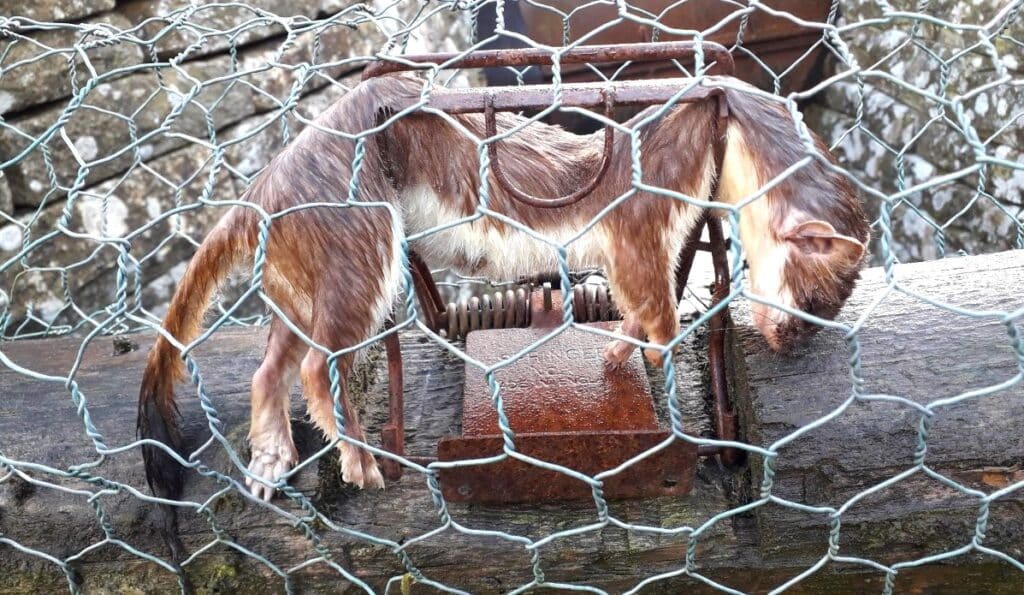
Stoat in a spring trap. Photo Bob Berzins
Traps and Snares
Before reading these points, take on board that the use of traps and snares simply to protect the profits of the shooting industry is still legal across the UK.
- Predators are not ‘pests’ or ‘vermin‘ they are wild animals and normal elements of every ecosystem on the planet.
- Yet government after government has sanctioned the mass killing of wild animals on shooting estates and grouse moors to protect the profits of the shooting industry.
- No one knows just how many traps and snares are laid on grouse moors because the industry is not obliged to report any data. However, the Scottish charity Revive estimated in a 2020 report that 57,000 killing devices were deployed each day in Scotland representing the equivalent of over 10,000,000 active trapping and snaring days per year.
- No one knows for certain exactly how many wild animals these traps and snares kill every year because there is no obligation to submit records.
- There is also no requirement to undertake ecological surveys to determine whether the killing of what is probably hundreds of thousands of animals a year is having any impact on local animal populations.
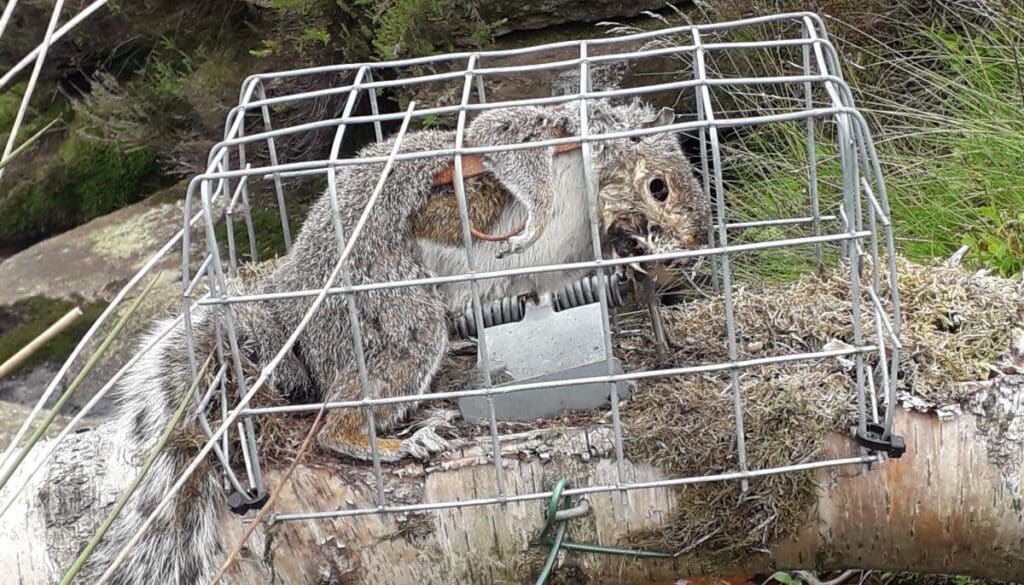
Grey Squirrel in Spring trap, Photo Bob Berzins
- While there is a requirement to use only certain traps and snares (see for example our Protectors page Spring Traps and the Law), enforcement is weak and in England there is no mandatory licencing system. If a gamekeeper chooses to use one, they just go ahead and do it.
- Stoats are a protected species – but not on shooting estates and grouse moors where they are subject to a General Licence (GL 38) that allows unlimited killing of stoats “to protect game birds [sic] in situations when they’re vulnerable to stoat predation”.
- Huge numbers of foxes are killed on shooting estates and grouse moors every year – simply, remember, to protect birds long enough for them to be sold to be shot (see Snares and the Shooting Industry).
- Up to 70% of animals caught in snares are so-called ‘non-target species’, including badgers, dogs, cats and deer. Pregnant and lactating animals may also become trapped.
- Snares are banned in almost every country in Europe. Wales took a major step towards passing a ban recently, Scotland may well ban them soon – but in a debate stuffed with pro-shooting MPs, the English Parliament decided to continue to allow their use.
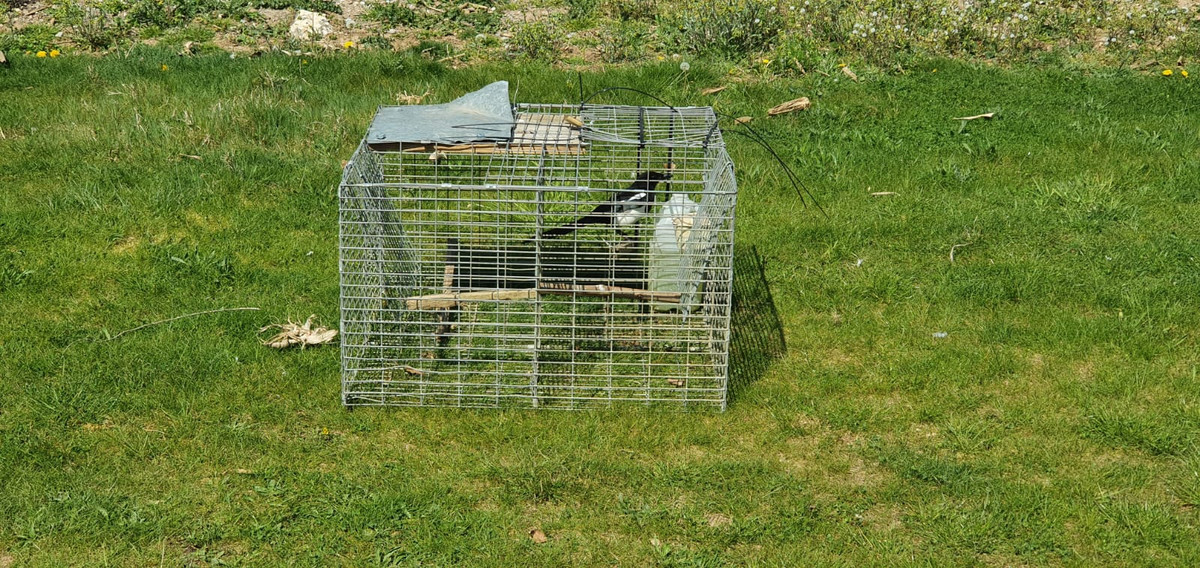
Magpie in larsen trap. Photo Shutterstock
- As well as spring traps and snares, gamekeepers use a range of cage traps to trap crows.
- Some of the most intelligent birds on the planet, crows are routinely caught and used as ‘calling birds’ to attract other birds to the trap. Other crows that have been trapped might be clubbed to death or shot right in front of them.
- Because all of these hideous tools are legal to use, if we try to release a trapped animal or damage a trap or a snare in any way we could be charged with criminal damage! Just for trying to help protect wild animals.
Raptor persecution
While all this killing (which is on top of the killing of hundreds of thousands of Red Grouse of course) is legal, the deliberate persecution of birds of prey is most definitely against the law. All birds of prey are protected (see our Protectors page on Birds of Prey and the Law). The shooting, trapping and poisoning of any bird of prey or their chicks is a crime and is therefore ‘raptor persecution’.
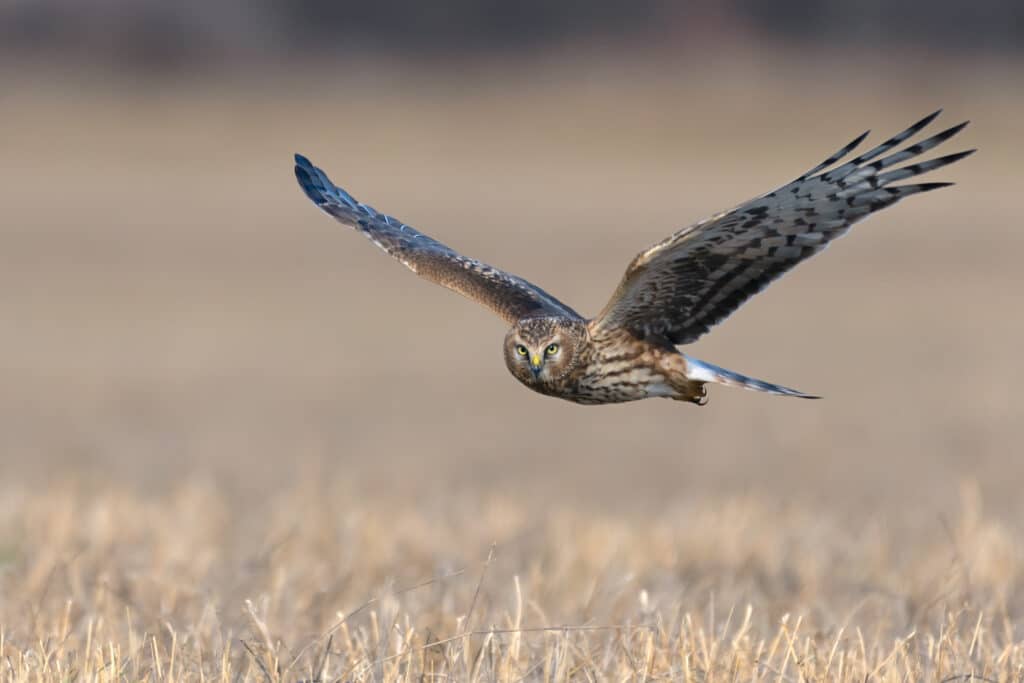
Hen Harrier, perhaps the most persecuted of all Britain’s birds of prey. Photo Shutterstock
- Birds of prey are still being widely persecuted on shooting estates and grouse moors. Their crime? Feeding their young on a wide-ranging diet that perhaps includes the birds that estates want to sell to shooters.
- Recorded incidents are widely acknowledged to be the ‘tip of the iceberg’. Most persecution takes place on huge estates well away from the public, investigators, and police officers.
- According to the RSPB more than two-thirds of all confirmed incidents of raptor persecution in 2021 were related to land managed for shooting.
- It is extremely hard to prove raptor persecution as there are rarely witnesses: there were only five convictions for raptor persecution in 2021 for example – but all five people convicted were gamekeepers.
- The RSPB says that a minimum of 68 Golden Eagles have been illegally killed in Scotland since 1981, the vast majority falling victim to illegal poisoning on grouse moors.
- In 2021 a Golden Eagle was found poisoned beside a dead hare laced with a banned pesticide, on a grouse shooting estate with a history of raptor persecution within the Cairngorms National Park.
- The influential Raptor Persecution UK blog has kept a rolling tally of Hen Harriers (a moorland breeding bird of prey) confirmed ‘missing’ or illegally killed in the UK since 2018, most of them on or close to grouse moors: as of August 2023 the tally stands at a staggering 98 birds! Yes, that’s 98 Hen Harriers ‘disappeared’ or illegally killed since 2018!
- The government’s own research concluded in 2019 that 72% of the 58 Hen Harriers they had satellite-tagged (so they could track their movements) were confirmed or considered likely to have been illegally killed.
- Hen Harriers are ten times more likely to occur over areas of land managed for grouse shooting relative to other land uses.
- In 2017 just FOUR pairs of Hen Harriers bred successfully in the whole of England! Research suggests there should be hundreds of pairs.
- In December 2022 we reported that a Hen Harrier nest on a grouse moor in a National Park had been attacked and the chicks stamped to death.
- In May 2023 a Natural England staff member wrote a blog about Free, a Hen Harrier killed on a grouse moor. She stated that “the post-mortem examination concluded that Free’s leg had been torn off while he was alive, and that the cause of death was the head being twisted and pulled off while the body was held tightly”.
- In June we reported on a Short-eared Owl shot and killed on a Peak District grouse moor. An eyewitness saw the bird ‘explode in a puff of feathers’.
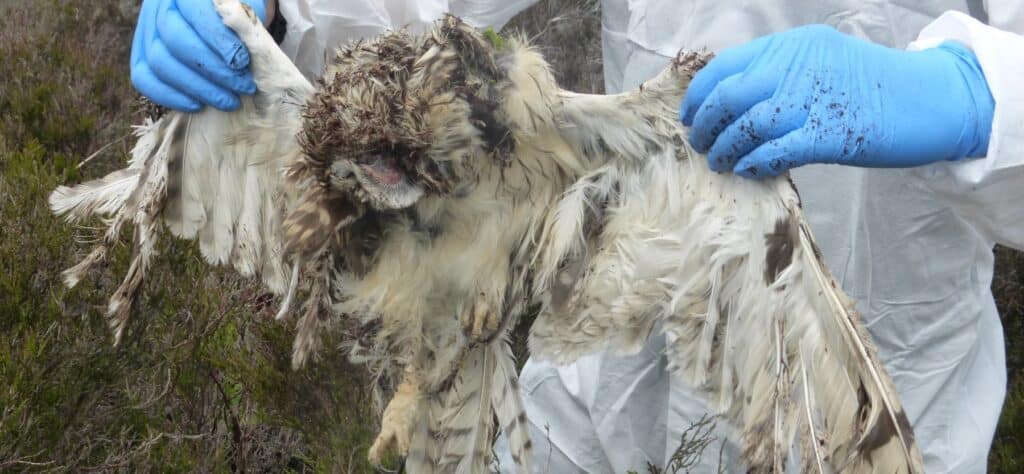
A Short-eared Owl shot on a grouse moor. Photo RSPB
- In March we reported on a Red Kite found “peppered with shotgun pellets” on a grouse moor in Co Durham (image above RSPB). The shooting took place just days after a witness reported the shooting of a Red Kite on a grouse shooting estate near Grantown-on-Spey.
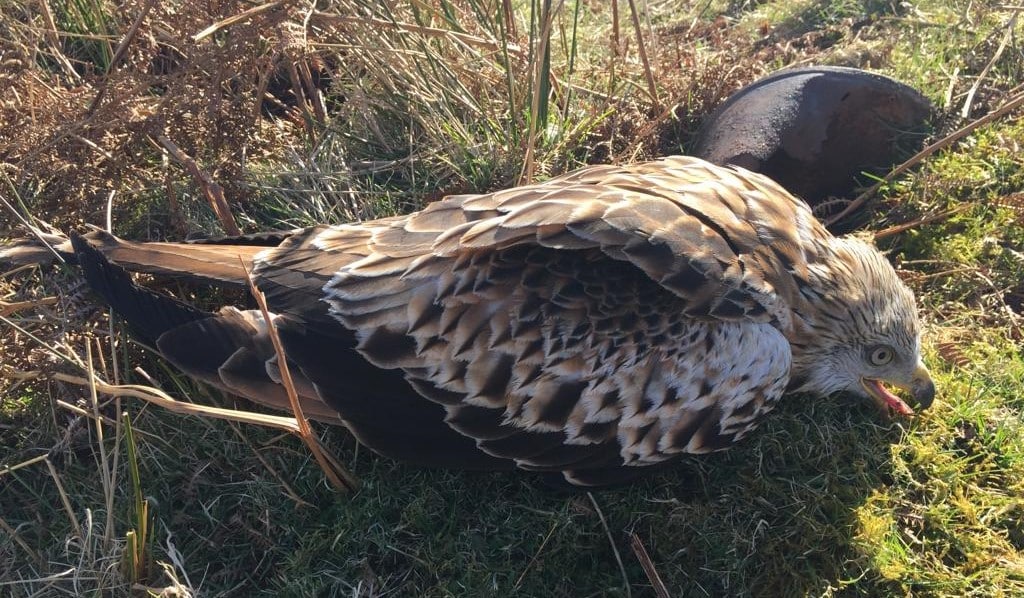
Red Kite shot on a grouse moor. Photo RSPB
These are just a handful of the many examples of the rampant and cruel wildlife crimes that take place on grouse moors.
UK governments have pledged to halt biodiversity decline by 2030. A key test will be whether we can coexist in harmony with birds of prey. For the vast majority of us, the answer will be ‘Of course we can’. We can not let the shooting industry decide otherwise.
Trapping, snaring, wildlife crime. Does that sound ‘glorious’ to you?
There is nothing remotely ‘glorious’ about August 12th. It’s a date which is synonymous with killing birds and mammals on a vast scale. Which is why it has been renamed by most pro-wildlife people and organisations like Protect the Wild as the ‘Inglorious 12th’.
It is quite simply about making as much money as possible by killing huge numbers of wild birds on moorland estates owned by so-called ‘aristocrats’ or hedge funds. It relies on intensive and destructive management, and its benefits are hugely overstated.
As well as the slaughter of hundreds of thousands of Red Grouse, untold numbers of animals are killed in snares and traps, and the whole sad and sorry industry is underpinned by wildlife crime.
Licencing moorland estates has been put forward as a way of controlling all this death and destruction. Tomorrowwe’ll explain why we are fundamentally opposed to the ‘licencing lifeline’.
- Subscribe to our Substack or support us as we work to shut the shooting industry down.


